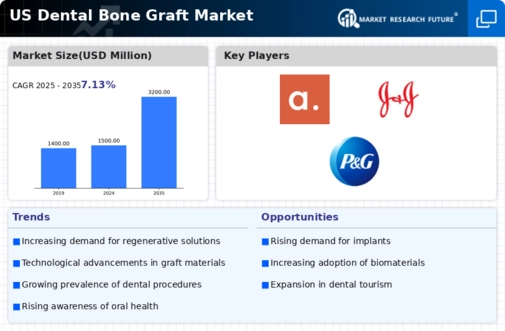Advancements in Biomaterials
Innovations in biomaterials are transforming the dental bone-graft market. The development of synthetic and natural graft materials, such as hydroxyapatite and collagen-based products, enhances the effectiveness and safety of bone grafting procedures. These advancements not only improve the integration of grafts with existing bone but also reduce the risk of complications. For instance, the introduction of bioactive materials that promote osteogenesis is gaining traction among dental practitioners. As a result, the market for these advanced biomaterials is expected to grow, with projections indicating a potential increase in market share by 15% over the next five years. This trend reflects a broader shift towards more effective and patient-friendly solutions in the dental bone-graft market.
Growing Aesthetic Consciousness
The rising emphasis on aesthetics among consumers is significantly influencing the dental bone-graft market. As individuals become more aware of the importance of oral health and its impact on appearance, the demand for cosmetic dental procedures, including implants supported by bone grafts, is increasing. Surveys indicate that nearly 60% of adults consider their smile a vital aspect of their overall appearance, driving them to seek restorative options. This trend is particularly pronounced among younger demographics, who are more likely to invest in dental aesthetics. Consequently, dental professionals are responding to this demand by incorporating bone grafting techniques into their practices, thereby contributing to the growth of the dental bone-graft market. The market is expected to see a notable rise in revenue, potentially reaching $1 billion by 2027.
Expanding Dental Insurance Coverage
The expansion of dental insurance coverage for bone grafting procedures is a crucial driver for the dental bone-graft market. As more insurance providers recognize the necessity of these procedures for successful dental implants, patient access to bone grafting is improving. This trend is particularly relevant in the context of rising healthcare costs, where patients are increasingly seeking insurance plans that cover essential dental services. Recent reports indicate that approximately 40% of dental insurance plans now include coverage for bone grafts, which is likely to encourage more patients to pursue necessary treatments. This shift not only enhances patient affordability but also stimulates demand within the dental bone-graft market, potentially leading to a market growth rate of 10% over the next few years.
Rising Prevalence of Dental Disorders
The increasing incidence of dental disorders, such as periodontitis and tooth loss, is a primary driver for the dental bone-graft market. As more individuals seek dental restoration solutions, the demand for bone grafting procedures rises. According to recent data, approximately 70% of adults aged 35 to 44 have lost at least one permanent tooth, which underscores the need for effective treatment options. This trend is likely to continue, as the population ages and dental health awareness increases. Consequently, dental professionals are increasingly utilizing bone grafts to enhance the success of dental implants and other restorative procedures, thereby propelling the growth of the dental bone-graft market. The market is projected to expand significantly, with estimates suggesting a compound annual growth rate (CAGR) of around 8% over the next several years.
Increased Investment in Dental Research
The dental bone-graft market is benefiting from heightened investment in dental research and development. Government and private sector funding for innovative dental solutions is on the rise, leading to breakthroughs in grafting techniques and materials. Research initiatives aimed at improving the efficacy of bone grafts and exploring new applications are gaining traction. For instance, studies focusing on stem cell therapy and tissue engineering are showing promise in enhancing bone regeneration. This influx of research funding is likely to foster innovation within the dental bone-graft market, potentially leading to the introduction of novel products and techniques. As a result, the market may experience accelerated growth, with forecasts suggesting an increase in market value by 20% over the next decade.














Leave a Comment